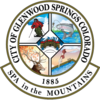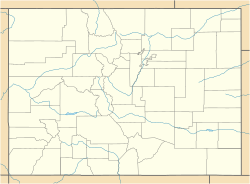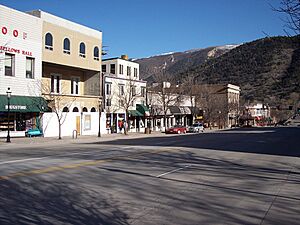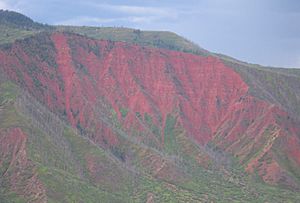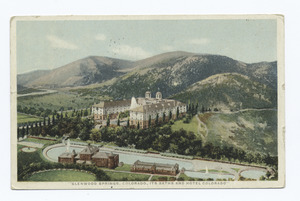Glenwood Springs, Colorado facts for kids
Quick facts for kids
Glenwood Springs, Colorado
|
|||||
|---|---|---|---|---|---|
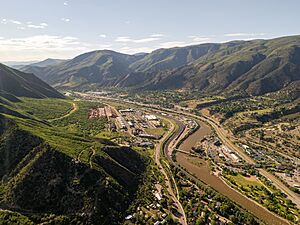
Drone View of Glenwood Springs
|
|||||
|
|||||
| Nickname(s):
Spa in the Mountains
|
|||||
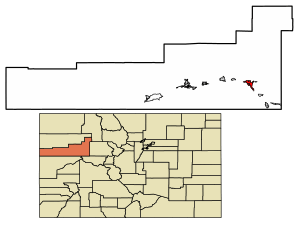
Location of the City of Glenwood Springs in Garfield County, Colorado
|
|||||
| Country | |||||
| State | |||||
| County | Garfield County seat | ||||
| Settled | 1883 | ||||
| Incorporated | September 4, 1885 | ||||
| Government | |||||
| • Type | Home Rule Municipality | ||||
| Area | |||||
| • Total | 5.844 sq mi (15.136 km2) | ||||
| • Land | 5.836 sq mi (15.114 km2) | ||||
| • Water | 0.008 sq mi (0.022 km2) | ||||
| Elevation | 5,761 ft (1,756 m) | ||||
| Population
(2020)
|
|||||
| • Total | 9,963 | ||||
| • Density | 1,707/sq mi (659/km2) | ||||
| • Metro | 79,043 | ||||
| • CSA | 134,774 | ||||
| Time zone | UTC−07:00 (MST) | ||||
| • Summer (DST) | UTC−06:00 (MDT) | ||||
| ZIP codes |
81601, 81602 (PO Box)
|
||||
| Area code(s) | 970 | ||||
| FIPS code | 08-30780 | ||||
| GNIS feature ID | 204659 | ||||
| GNIS City ID | 0 | ||||
Glenwood Springs is a city in Colorado, United States. It is the main city of Garfield County. In 2020, about 9,963 people lived there. Glenwood Springs is located where the Roaring Fork River and the Colorado River meet. It is famous for its natural hot springs.
Contents
History of Glenwood Springs
Glenwood Springs was first called "Defiance." The wife of the town's founder, Sarah Cooper, found it hard to get used to life on the frontier. To make her feel more at home, she convinced the founders to change the name to Glenwood Springs. This was after her favorite hometown, Glenwood, Iowa.
Because of its location and a new railroad stop, Glenwood Springs quickly became an important trading center. Many famous people have visited the city. President Theodore Roosevelt spent a whole summer at the historic Hotel Colorado. Doc Holliday, a famous Wild West figure, spent his last months in Glenwood Springs. He is buried in the town's old Pioneer Cemetery.
Glenwood Springs was one of the first places in the United States to have electric lights. The first lights were put in the Fairy Caves in Iron Mountain in 1897. Later, a dam was built in Glenwood Canyon. This dam provided water for the Shoshone power plant. The plant started making electricity in 1909. It still has the oldest and largest rights to the Colorado River's water.
Geography and Nature
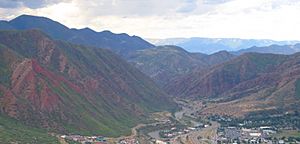
Glenwood Springs is in narrow mountain valleys. Here, the Colorado River and the Roaring Fork River join together. The land around the city is very steep, with many caves. There are also many geothermal resources, which means hot water from underground. The hot springs are the most famous example of this.
Glenwood Springs is known as one of the most walkable towns in America. This means it's easy to get around on foot. There are many trails for walking and biking throughout and around the city. These trails were built starting in the 1980s to help with traffic.
The city has very good water rights to the rivers nearby. This means it has a lot of clean drinking water. The water comes from major rivers in the Flat Tops Wilderness Area. The tap water is usually very good quality.
There are many mineral deposits further up the Crystal River and the Roaring Fork. There is also a lot of petroleum (oil) in western Garfield County. This brings a lot of tax money to Glenwood Springs. However, Glenwood Springs itself does not have these minerals or oil nearby. This means the city has clean air, water, and land, unlike some other old mining towns in Colorado.
According to the U.S. Census Bureau, Glenwood Springs covers about 14.7 square kilometers (5.7 square miles). Only a very small part of this is water.
People and Population
| Historical population | |||
|---|---|---|---|
| Census | Pop. | %± | |
| 1890 | 920 | — | |
| 1900 | 1,350 | 46.7% | |
| 1910 | 2,019 | 49.6% | |
| 1920 | 2,073 | 2.7% | |
| 1930 | 1,825 | −12.0% | |
| 1940 | 2,253 | 23.5% | |
| 1950 | 2,412 | 7.1% | |
| 1960 | 3,637 | 50.8% | |
| 1970 | 4,106 | 12.9% | |
| 1980 | 4,637 | 12.9% | |
| 1990 | 6,561 | 41.5% | |
| 2000 | 7,736 | 17.9% | |
| 2010 | 9,614 | 24.3% | |
| 2020 | 9,963 | 3.6% | |
| U.S. Decennial Census | |||
Glenwood Springs is the main city of the Glenwood Springs, CO Micropolitan Statistical Area.
In 2000, there were 7,736 people living in the city. About 30% of households had children under 18. The average age of people in the city was 36 years old. Glenwood Springs has a high life expectancy for people who work there.
Economy and Jobs
Glenwood Springs is not mainly a bedroom community. This means most people who live there also work there. In 2015, Bloomberg Business said Glenwood Springs was the seventh wealthiest small town in America. This is partly because of its closeness to Aspen, a very rich area. Many small businesses start here.
A ranch in Glenwood Springs grows Red Delicious apples.
Top Employers
Here are the biggest employers in Glenwood Springs as of 2022:
| # | Employer | Employee Range |
|---|---|---|
| 1 | Valley View Hospital | 1,000 - 1,250 |
| 2 | Lowe's Home Improvement | 250 - 499 |
| 3 | Walmart | 250 - 499 |
| 4 | City Market | 250 - 499 |
| 5 | Colorado Mountain College | 250 - 499 |
| 6 | Target | 250 - 499 |
| 7 | Glenwood Caverns Adventure Park | 100 - 249 |
| 8 | Glenwood Hot Springs Resort | 100 - 249 |
| 9 | Roaring Fork School District RE-1 | 100 - 249 |
| 10 | City of Glenwood Springs | 100 - 249 |
Arts and Culture
The Strawberry Days Festival started in 1898. It is Colorado's oldest festival. It is also the oldest continuous celebration west of the Mississippi River.
Parks and Recreation
Hot Springs
There are many hot springs in the area. Some pools in town have temperatures from 93 to 104 degrees Fahrenheit (34 to 40 degrees Celsius). Native Americans believed these springs had healing powers. The Utes thought the springs were sacred before the 1800s.
The Yampah Hot Springs vapor caves are underground steam baths. The Ute people used them for healing. These caves have three rock chambers, and the temperature is usually about 110 to 112 degrees Fahrenheit (43 to 44 degrees Celsius).
Iron Mountain Hot Springs also has mineral water pools for soaking.
Water Sports
Glenwood Springs is a great place for fishing. There is also a special park for whitewater sports called Glenwood Whitewater Park.
Bike Trails
Two bike trails end in Glenwood Springs. The Glenwood Canyon Recreational Trail is about 16 miles long and goes through Glenwood Canyon. The Rio Grande Trail is about 41 miles long and follows an old railroad line to Aspen.
Glenwood Caverns Adventure Park
Glenwood Caverns Adventure Park is a fun park located near Glenwood Springs. It has rides and attractions inside and outside caves.
Glenwood Vaudeville Revue
The Glenwood Vaudeville Revue started in 2009. It performs a dinner theater show in a renovated movie theater downtown.
Education
Schools for Kids
Public schools in Glenwood Springs are managed by Roaring Fork Schools. These include:
- Glenwood Springs Elementary School
- Sopris Elementary School
- Riverview School
- Glenwood Springs Middle School
- Glenwood Springs High School
St. Stephen Catholic School offers elementary and middle school classes. Yampah Mountain School in Glenwood Springs offers different ways to learn.
Colleges and Universities
Colorado Mountain College has two campuses in Glenwood Springs. One is downtown, and the other is the Spring Valley residential campus just south of the city.
The University of Denver also has a program in Glenwood Springs. It trains students to be social workers in smaller, rural communities.
Media
The main news source for Glenwood Springs is the Post Independent. This is a local daily newspaper. It was formed when two older newspapers, the Glenwood Post and the Glenwood Independent, joined together. It has won many awards.
KMTS plays local country radio along the Colorado River. KSNO-FM serves the Roaring Fork Valley.
The town also has local TV channels like KREG-TV.
Transportation
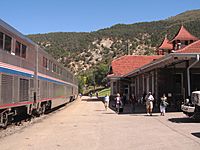
Trains
Amtrak's California Zephyr train stops daily in Glenwood Springs. This train travels between Chicago and Emeryville, California. Glenwood Springs is the second busiest Amtrak station in Colorado, after Denver's Union Station.
Since 2021, a luxury train company called Rocky Mountaineer also offers trips. It goes between Moab, Utah and Denver, with an overnight stop in Glenwood Springs.
The local transportation group is the Roaring Fork Transportation Authority (RFTA).
Buses
RFTA provides bus service in Glenwood Springs and the surrounding valley. Their VelociRFTA (sounds like "Veloci-rafta") BRT service started in 2013. It is the first rural BRT in the United States. It connects south Glenwood Springs to Aspen, with buses running often.
The city also has its own bus service called Ride Glenwood. It travels through downtown and other parts of the city.
Greyhound Lines also stops in Glenwood Springs on its long-distance trips. Bustang provides bus service twice a day to Grand Junction and Denver.
Cars
Glenwood Springs is located along I-70. This is a major highway that goes through the Rocky Mountains. It's about 150 miles (240 km) west of Denver. Colorado State Highway 82 goes southeast from Glenwood Springs to Carbondale and Aspen.
Airport
Glenwood Springs has a small municipal airport. It was built in the early 1940s.
Notable People
Many interesting people have lived in or are connected to Glenwood Springs:
- Louis Alterie (1886–1935), a Chicago gangster.
- Alice McKennis Duran (born 1989), a skier.
- Jeanne Golay (born 1962), a bike racer and Olympian.
- Sacha Gros (born 1974), an alpine skier.
- Justin Hocking (born 1973), a writer.
- Doc Holliday (1851–1887), a famous Wild West gunfighter and dentist.
- Jeremy Hubbard (born 1972), a news anchor.
- James Irwin (1930–1991), a NASA astronaut and the eighth person to walk on the Moon.
- Elizabeth Jaranyi (1918–1998), a Holocaust survivor.
- Jack P. Juhan (1904–2002), a U.S. Marine Corps major general.
- Bobby Julich (born 1971), a bike racer and Olympic medalist.
- Benjamin Kunkel (born 1972), a novelist.
- Harvey Logan (1867–1904), a Wild West outlaw.
- Berenice Mallory (1901–1997), a home economist and educator.
- Scott McInnis (born 1953), a former U.S. congressman.
- Blake Paul Neubert (born 1981), a painter.
- Clifford C. Parks (1860–1937), a politician.
- Sarah Schleper (born 1979), an alpine skier.
- Edward T. Taylor (1858–1941), a politician.
- Ledyard Tucker (1910–2004), a mathematician.
- John D. Vanderhoof (1922–2013), the 37th governor of Colorado.
- Francis Whitaker (1906–1999), a blacksmith.
See also
 In Spanish: Glenwood Springs para niños
In Spanish: Glenwood Springs para niños



